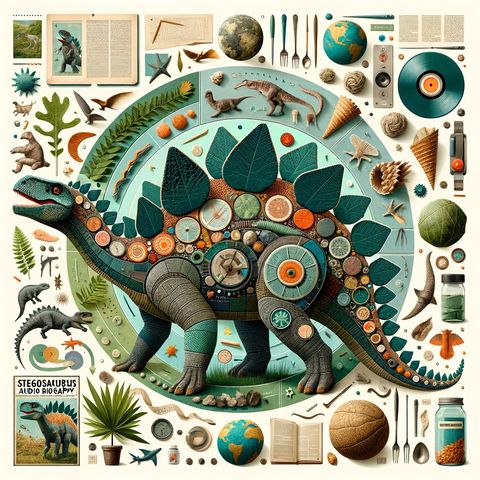Unraveling the Enigma of Stegosaurus: An Iconic Jurassic Giant

Descarga y escucha en cualquier lugar
Descarga tus episodios favoritos y disfrútalos, ¡dondequiera que estés! Regístrate o inicia sesión ahora para acceder a la escucha sin conexión.
Unraveling the Enigma of Stegosaurus: An Iconic Jurassic Giant
Esta transcripción es generada automáticamente. Ten en cuenta que no se garantiza una precisión absoluta.
Descripción
In the lush forests and plains of the late Jurassic period, some 150 million years ago, roamed one of the most iconic and recognizable dinosaurs of all time - the...
mostra másStegosaurus, whose name means "roofed lizard," was first discovered in 1877 by Othniel Charles Marsh during the infamous "Bone Wars" - a period of intense rivalry and competition between paleontologists. The initial discovery took place in Morrison, Colorado, which would later become part of the renowned Morrison Formation, a rich source of Jurassic fossils.
Standing at about 9 feet tall at the hips and measuring up to 30 feet in length, Stegosaurus was a formidable presence in its ecosystem. Its most striking feature was undoubtedly the double row of large, upright plates that ran along its back. These plates, which could reach up to 2 feet in height, were not solid bone but rather consisted of a bony core covered with a horn-like material.
For years, scientists debated the purpose of these plates. Early theories suggested they were used for defense, but their relatively thin and fragile nature made this unlikely. More recent hypotheses propose that the plates served as a form of thermoregulation, helping the animal to heat up or cool down by controlling blood flow through the plates. Another intriguing possibility is that they were used for display, possibly to attract mates or intimidate rivals, much like a peacock's tail.
At the end of its tail, Stegosaurus wielded a formidable weapon - a cluster of four long spikes known as the thagomizer. This term, humorously coined by cartoonist Gary Larson in a 1982 Far Side comic, has since been adopted by paleontologists. These spikes, each up to 3 feet long, were likely used for defense against predators like the fearsome Allosaurus.
Despite its imposing size and defensive capabilities, Stegosaurus had a brain no larger than a dog's - about the size of a walnut. This led to the misconception that it was one of the least intelligent dinosaurs. However, brain size doesn't always correlate directly with intelligence, and Stegosaurus was likely well-adapted to its environment.
Stegosaurus was an herbivore, with a beak-like mouth and small, leaf-shaped teeth perfect for stripping vegetation. Its long neck allowed it to reach both low-growing plants and higher branches. Interestingly, it lacked the grinding teeth found in many other herbivorous dinosaurs, suggesting it may have swallowed gastroliths - stones that helped grind food in its stomach.
The social behavior of Stegosaurus remains a topic of debate among paleontologists. While some evidence suggests they may have lived in herds, other findings indicate they might have been solitary creatures. The discovery of multiple Stegosaurus fossils in the same location, including juveniles, has led some researchers to speculate about possible family groups or temporary gatherings.
Stegosaurus lived during a time of great diversity in dinosaur species. It shared its habitat with other well-known dinosaurs such as Allosaurus, Apatosaurus, and Diplodocus. This period saw the rise of large sauropods and the evolution of various defensive adaptations in herbivorous dinosaurs, of which Stegosaurus's plates and spikes are prime examples.
The legacy of Stegosaurus extends far beyond its prehistoric existence. It has become one of the most recognizable dinosaurs in popular culture, featured in countless books, movies, and television shows. Its distinctive silhouette has become synonymous with the concept of dinosaurs in the public imagination.
In the realm of science, Stegosaurus continues to be a subject of fascination and study. New discoveries and advanced technologies allow paleontologists to gain ever more detailed insights into its anatomy, behavior, and place in the Jurassic ecosystem. From CT scans of fossils to computer simulations of its movement and thermoregulation, our understanding of this ancient creature continues to evolve.
As we look back across the vast expanse of time to the age of dinosaurs, Stegosaurus stands out as a testament to the incredible diversity and adaptability of life on Earth. Its unique features and enduring presence in our collective imagination ensure that this "roofed lizard" will continue to inspire wonder and curiosity for generations to come.
This is a Quiet Please production for more go to http://www.quietperiodplease.com
Check out these Dino Deals https://amzn.to/4dSqNXR
Información
| Autor | QP - Daily |
| Organización | William Corbin |
| Página web | - |
| Etiquetas |
Copyright 2024 - Spreaker Inc. an iHeartMedia Company

Comentarios